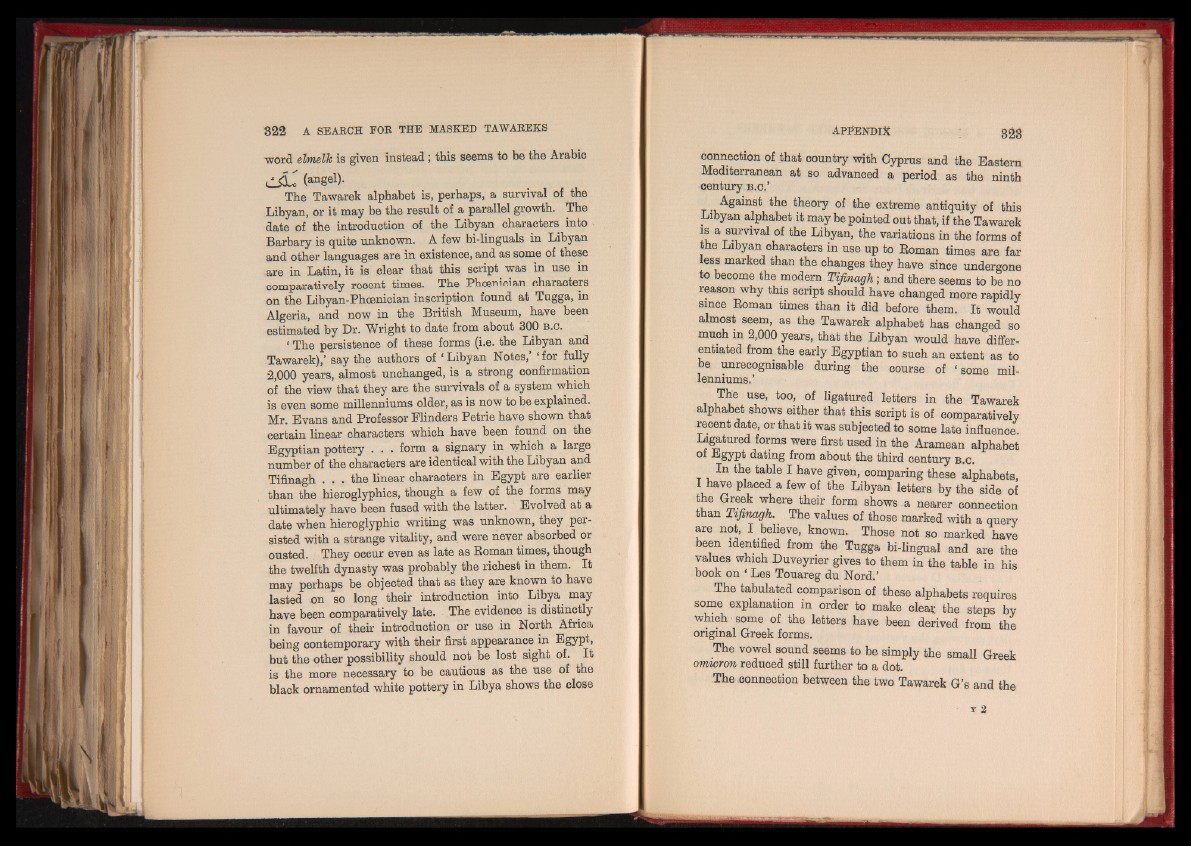
word elmelk is given instead; this seems to be the Arabic
c J L (an§e1)-
The Tawarek alphabet is, perhaps, a survival of the
Libyan, or it may be the result of a parallel growth. The
date of the introduction of the Libyan characters into
Barbary is quite unknown. A few bi-linguals in Libyan
and other languages are in existence, and as some of these
are in Latin, it is clear that this script was in use in
comparatively recent times. The Phoenician characters
on the Libyan-Phoenician inscription found at Tugga, in
Algeria, and now in the British Museum, have been
estimated by Dr. Wright to date from about 300 B.C.
I The persistence of these forms (i.e. the Libyan and
Tawarek),’ say the authors of ‘ Libyan Notes, for fully
2,000 years, almost unchanged, is a strong confirmation
of the view that they are the survivals of a system which
is even some millenniums older, as is now to be explained.
Mr. Evans and Professor Flinders Petrie have shown that
certain linear characters which have been found on the
Egyptian pottery . . . form a signary in which a large
number of the characters are identical with the Libyan and
Tifinagh . . . the linear characters in Egypt are earlier
than the hieroglyphics, though a few of the forms may
ultimately have been fused with the latter. Evolved at a
date when hieroglyphic writing was unknown, they persisted
with a strange vitality, and were never absorbed or
ousted. They occur even as late as Roman times, though
the twelfth dynasty was probably the richest in them. It
may perhaps be objected that as they are known to have
lasted on so long their introduction into Libya may
have been comparatively late. The evidence is distinctly
in favour of their introduction or use in North Africa
being contemporary with their first appearance in Egypt,
but the other possibility should not be lost sight of. It
is the more necessary to be cautious as the use of the
black ornamented white pottery in Libya shows the close
connection of that country with Cyprus and the Eastern
Mediterranean at so advanced a period as the ninth
century b .c.’
Against the theory of the extreme antiquity of this
Libyan alphabet it may be pointed out that, if the Tawarek
is a survival of the Libyan, the variations in the forms of
the Libyan characters in use up to Roman times are far
less marked than the changes they have since undergone
to become the modern Tifinagh; and there seems to be no
reason why this script should have changed more rapidly
since Roman times than it did before them. It would
almost seem, as the Tawarek alphabet has changed so
much in 2,000 years, that the Libyan would have differentiated
from the early Egyptian to such an extent as to
be unrecognisable during the course of ‘some millenniums.’
The use, too, of ligatured letters in the Tawarek
alphabet shows either that this script is of comparatively
recent date, or that it was subjected to some late influence.
Ligatured forms were first used in the Aramean alphabet
of I^Sypt dating from about the third century B.C.
In the table I have given, comparing these alphabets,
I have placed a few of the Libyan letters by the side of
fte fk where their form shows a nearer connection
than Tifinagh. ^ The values of those marked with a query
are not, I believe, known. Those not so marked have
been identified from the Tugga bi-lingual and are the
values which Duveyrier gives to them in the table in his
book on ‘ Les Touareg du Nord.’
The tabulated comparison of these alphabets requires
some explanation in order to make clear the steps by
which some of the letters have been derived from the
original Greek fo rm a .
The vowel sound seems to be simply the small Greek
omicron reduced still further to a dot.
The connection between the two Tawarek G’s and the